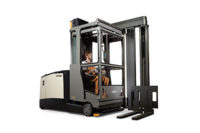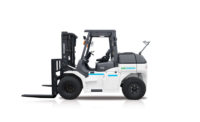Whether it be Internet of Things (IoT), advanced robotics or alternative energy, technology is impacting the lift truck industry at an accelerated pace. Intelligent systems collect and share data with fleet owners. Alternatively powered vehicles impact a company’s bottom line. And, space conservation is in high demand.
In this special report, some of the industry’s leading lift truck providers discuss trends, challenges, new product development and how lift trucks are changing the future of the industry.
Telematics, robotics rule the playing field
These days, businesses turn to data-driven intelligence to guide decisions that improve efficiency and protect the bottom line, says Mick McCormick, vice president of warehouse solutions for Yale Materials Handling Corp., Greenville, N.C.
“For lift truck fleets, telemetry programs can produce a wealth of relevant data insights for quick conversion into actionable business intelligence,” he adds.
That’s why Yale introduced Yale Vision, a telemetry system that evaluates utilization and maintenance information, allowing fleet managers to make quick, informed decisions about fleet size and composition. The system also allows operations to connect to any cellular network as well as the flexibility to be installed on virtually any moving warehouse asset, says McCormick.
Forklifts are also becoming more “connected,” thanks to vehicle management systems like T-Matics MOBILE, a forklift-based system designed to increase productivity and create safety and operational benefits to forklift fleet owners. Developed by Toyota Material Handling USA, Columbus, Ind., in partnership with Sprint, Overland Park, Kan., T-Matics MOBILE helps users track forklifts for better operational visibility, gain and analyze unique data and facilitate data-driven decisions.
For its part, The Raymond Corp., Greene, N.Y., offers the iWAREHOUSE telematics system, which reports on forklift utilization and maintenance data for operator efficiency.
“Processors can take a close look at the data they collect on their lift trucks, often done through a telematics system like iWAREHOUSE, and look for ways to make sure trucks are up and running as much as possible and that they’re being used for the right tasks,” says John Rosenberger, manager for global telematics and the company’s iWAREHOUSE GATEWAY. “We also find that companies don’t realize they already have other systems in place that could feed a bigger data-type analysis. Many times, customers think they have to collect more data or find new ways to get information, when in reality they already have the data they need — it’s just siloed and being looked at by only one department rather than as a whole set of data. They can actually use the wealth of data they already collect in their warehouse to improve equipment and labor efficiency.”
Electric vs engine-powered
In general, electric trucks are better suited for indoor applications, but new designs, features and options are driving the trend from internal combustion (IC) engines to electric for certain applications, says McCormick. In fact, Yale’s IC trucks feature Yale Flex Performance Technology, which offers selectable performance modes that tailor a truck’s performance based on operational demands.
“Yale allows customers to break free from the constraints of traditional IC models by optimizing our electric trucks with options suited for outdoor, wet, corrosive and washdown applications,” he adds.
Yale also partners with Nuvera Fuel Cells LLC, Billerica, Mass., to combine its material handling industry expertise with Nuvera’s zero-emissions fuel cell technology to create a turnkey solution that reduces emissions and improves performance. Yale also harnesses Driven by Balyo technology to transform some of its lift trucks to robotic solutions. Produced by Balyo Inc., Boston, the Driven by Balyo technology enables trucks to navigate without the help of any reflectors, wires or magnets. Furthermore, Yale offers what is said to be the first UL-recognized lithium-ion battery pack in the forklift industry, designed to last up to five times longer than traditional lead acid batteries.
For its part, Mitsubishi Caterpillar Forklift America Inc. (MCFA), Houston, Texas, developed a slew of electric lift trucks under the Jungheinrich brand.
“Although there is an initial expense of purchasing a battery and charger, the electric pneumatics have the ability to run up to two shifts on a single battery charge, which is unique in the industry,” says Perry Ardito, general manager of warehouse products for MCFA. “With the long run times on the Jungheinrich units, customers can often reduce their fleet and battery charging stations, [making for] an even greater return on investment in the long run.”
Plus, low temperatures can decrease battery life. Jungheinrich’s 48-volt battery and cold storage cab option help maximize productivity with lower energy consumption.
New racking systems take on an e-commerce world
Fueled by e-commerce growth, warehouses are changing the way they fulfill orders, says Brian Neuwirth, vice president of UNEX Manufacturing, Lakewood, N.J.
“Instead of bringing the pickers to the goods to pick items, companies are using automation to take goods to the person. Order pickers do not need to walk the warehouse; instead products come to them on conveyors, automated storage and retrieval systems, mobile storage shelves, etc.,” he adds.
That’s why UNEX introduced new light and heavy-duty options for its patented Span-Track carton flow and storage system, which optimizes product flow, eliminates hang-ups on the track, produces high throughput and offers low-temperature capabilities for freezers and coolers as low as -20°F.
UNEX also introduced Pick-Plank, a mechanical order picking device that affixes to a pallet and converts each pick slot from a static to a dynamic storage position. The Pick-Plank is made of industrial steel that holds up to 1,200 pounds. Once items in the front are picked, the worker unlocks the guide and slides the back half of the pallet to the front position, moving all products to the front of the aisle, making for a quicker and easier pick procedure.
Last year, Hannibal Industries Inc., Los Angeles, received a U.S. patent for TubeRack, what is said to be a stronger, safer and smarter alternative to conventional racking systems. TubeRack’s modular design is engineered to be more impact resistant and offer better tolerances. Plus, its dual-moment frame allows flexibility both front-to-back and side-to-side to withstand impacts and seismic activity.
“Our customers are looking to fit more SKUs in their facilities, increase space utilization and keep labor costs down,” says Steve Rogers, vice president of Hannibal Industries. “The industry should never stop trying to build smarter and more technologically advanced racking systems for the global economy. This includes new ways to store and move product, as well as how to move and build the systems themselves—with considerations for shipping, design and increased systemic precautions.”
The future
“I think challenging the status quo will be the future of the lift truck industry—pushing the envelope to develop more innovative and intelligent lift trucks and solutions,” says Mark Hoch, director, national accounts for food and beverage for Hyster Co., Greenville, N.C.
And, of course, technology brings added complexity, says Andy Smith, director of marketing product management for Crown Equipment, New Bremen, Ohio.
“Even the best-designed technologies require learning curves, process changes and new behaviors,” he adds. “That’s why it is essential we collaborate with processors to develop innovative approaches that minimize complexity, simplify implementation and enhance the customer experience.”
Thanks to enhanced technology, today’s lift trucks and racking solutions are stacking up to be a game-changer in the industry.






